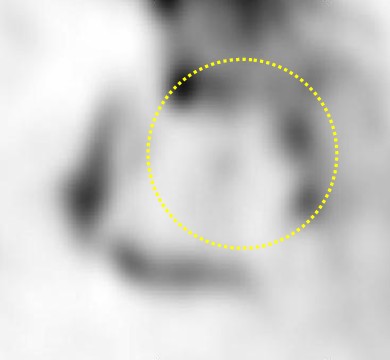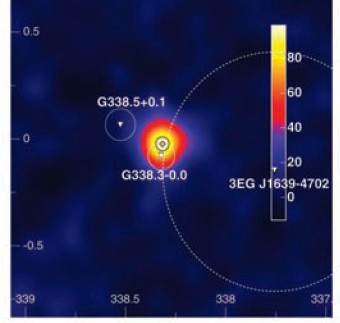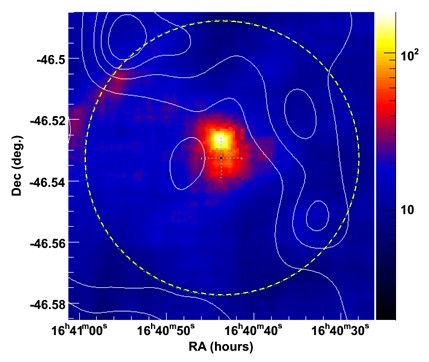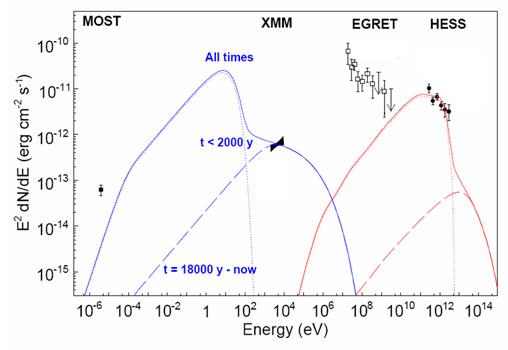HESS J1640-465 - A Pulsar Wind Nebula?
March 2007

The gamma-ray source HESS J1640-465 (Fig. 1) was discovered during the survey of the Galactic plane; with a size of 0.045 degrees it is among the most compact sources in the survey, and just recognized as an extended source. A possible identification of the object is based on radio and X-ray data. HESS J1640-465 roughly coincides with the supernova remnant G338.3-0.0, detected in radio observations at 843 MHz (Whiteoak and Green, 1996, see top figure). A faint ASCA X-ray source, AX J1640.7-4632 (Sugizaki et al. 2001), coincides with the position of the H.E.S.S. source and could be indicative of a pulsar created in the supernova explosion, although no pulsed radio emission has been detected from the region. At higher energies, INTEGRAL detected the source IGR J16393-4643 (Malizia et al. , 2004).
New constraints on the nature of the gamma-ray source come from sensitive X-ray observations with XMM-Newton (Funk et al. 2007): at the center of the H.E.S.S. source, an extended and slightly asymmetric X-ray source is found (Fig. 2), reminiscent of typical pulsar wind nebulae (PWN). In a PWN, a relativistic flow of electrons and positrons terminates in a shock, from where the a wide energy spectrum of particles emerges and feeds an extended nebula, visible in X-ray synchrotron radiation and in high-energy gamma rays resulting from upscattering of ambient low-energy photons such as the cosmic microwave background. However, the size of the X-ray source is significantly smaller than the H.E.S.S. gamma-ray source, and also the energy flux in X-rays is about an order of magnitude lower than the flux in gamma rays (Fig. 3). The latter observation is particularly surprising, since for typical interstellar magnetic fields one expects equal or higher energy flux in X-rays.
One possible interpretation is discussed by Funk et al. (2007), and serves to illustrate some of the mechanisms active in pulsar wind nebulae in general. The energy source of the nebulae is the is rotational energy of the pulsars; young pulsars rotate rapidly and radiate energy at high rate, whereas the energy flow decreases as the pulsar spins down, roughly as 1/age2. Therefore, most of the energy fed into the pulsar wind nebula can be attributed to the phase right after the birth of the pulsar. Unless magnetic fields in the nebula are strong, such "relic" electrons with energies up to several TeV survive some 10 kyears and are still around to generate gamma-rays by Inverse Compton upscattering (dotted line in Fig. 3). However, to generate synchrotron X-rays at keV energies in typical fields of some 5-10 micro-Gauss, much higher electron energies around 100 TeV and above are needed. Due to strong radiative energy losses, such electrons have much shorter lifetimes of a few 1000 years, and only "recently" generated electrons contribute. Since the current spin-down energy loss of the pulsar is small compared to that of the young pulsar, the number of such electrons and hence the X-ray flux is reduced. This model - also invoked for other sources such as HESS J1825-137 (Aharonian et al., 2006) - also explains the different source size; the "young" X-ray emitting electrons had much less time to propagate away from the pulsar than the "old" gamma-ray emitting electrons. However, another possible scenario cannot be ruled out at this moment: that the gamma-rays originate from particles accelerated in the supernova shell and are not directly related to the X-ray source connected to the pulsar.
References:
The H.E.S.S. survey of the Inner Galaxy in very high-energy gamma-rays, H.E.S.S. collaboration, F. Aharonian et al., Astrophysical Journal 636 (2006) 777-797


